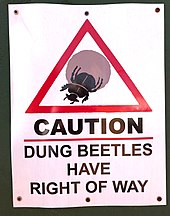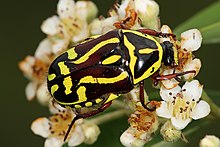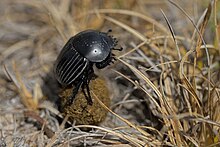Scarab beetle
| Scarab beetle | ||||||||||||
|---|---|---|---|---|---|---|---|---|---|---|---|---|

Shiny gold rose beetle ( Cetonia aurata ) |
||||||||||||
| Systematics | ||||||||||||
|
||||||||||||
| Scientific name | ||||||||||||
| Scarabaeidae | ||||||||||||
| Latreille , 1802 |


The scarab beetles (Scarabaeidae) are a family in the order of the beetles (Coleoptera), which includes very different animals. The group, which is very large with about 27,000 species in 1,600 genera, is distributed worldwide and consists of several well-defined subfamilies and a number of those whose relationship is still unclear. The number of species in the group is probably significantly higher, as many large subgroups, such as the Melolonthinae, have so far only been little researched. The system of scarab beetles has recently been heavily restructured and many subfamilies have been elevated to the rank of family within the superfamily Scarabaeoidea . Depending on the author, the number of specified subfamilies varies significantly.
features
Beetle
The adult beetles are 2.0 to 160.0 millimeters long. Their body shape is variable and ranges from ovoid, ovoid-flattened and rectangular to cylindrical. Their color is also variable. Many species are brightly colored and some have a metallic sheen. Scales or hairs can be formed. The head is rarely angled slightly downward. The antennae are usually ten-membered, very rarely only nine-membered and have a three- to seven-membered antenna lobe. The last members of the Melolonthinae , Dynastinae , Rutelinae , Cetoniinae , Trichiinae and Valginae are hairless, in the Aphodiinae and Scarabaeinae they are provided with toment . The compound eyes are partially divided and have fully developed (eucone) ommatidia . The frontal plate ( clypeus ) has tubercles or horn-like appendages in some species. The labrum is usually clearly formed and in some species protrudes beyond the tip of the front plate. The mandibles are formed differently and in some species extend beyond the tip of the labrum. The maxillary palps are four-limbed, the labial palps three- limbed .
The pronotum is also variable and in some species can have tubercles or horn-like appendages. The wings (elytres) are flat or convexly curved and have longitudinal grooves in some species. The pygidium of the Aphodiinae is covered by the wings, otherwise it is exposed in most of the other subfamilies. The triangular, flat to parabolic shield ( scutellum ) can be exposed or hidden. The hips ( coxes ) of the legs are oblique or conical. The rails ( tibia ) of the forelegs have either two, three or four teeth or are sawn on the outer edge. Your apex carries a spur. The tibiae of the rest of the legs are slender or strong and have one or two spurs at their apex. In some species of Scarabaeinae, the tarsi on the front legs are missing . The claws are designed to be variable. They are the same or different sizes, simple or toothed. An empodium is trained.
The abdomen has six visible sternites . The seven functional spiracles of the Aphodiinae and Scarabaeinae are in the pleural membranes, in most of the other subfamilies they are in the pleurites, sternites and tergites . The genitals of the males are variable. They have a double lobe or are fused.
Larvae
The larvae have a C-shaped curved body. In some species, such as most Scarabaeinae, they are slightly humped. Their antennae are usually four-parted. Point eyes ( Ocelli ) are not developed in most species, they are only found in some Dynastinae and Cetoniinae. A frontoclypeal suture is formed. The tip of the labrum is rounded or lobed. The epipharynx is also rounded or lobed and asymmetrical. The Galea and Lacinia are clearly separated from each other in the Aphodiinae and Scarabaeinae or grown together to form a mala in the other subfamilies. A maxillary stridulation organ is usually formed. The spiracles are sieve-shaped (cribriform). The legs of the Scarabaeinae are three-part, otherwise five-part. They have no organ to produce sound. Most species have claws. In some species a fleshy lobe is formed on the ventral side of the last abdominal segment.
Way of life and food
The scarab beetle's way of life is extremely diverse. It ranges from the ordinary outdoor life to the specialized way of life that is highly adapted to living with social insects, or even includes brood care , where the adults live with the brood they cherish. The food spectrum ranges from dung, carrion, humus and mushrooms to all parts of living plants. There are many species that are considered beneficial insects, such as some species of the Scarabaeinae and Aphodiinae , while some herbivorous species, such as the subfamilies Melolonthinae , Rutelinae and Dynastinae , are serious pests in agriculture and forestry. In the lowlands of Peru, a scarab beetle, Deltochilum valgum , was discovered for the first time in 2008, and it loves to hunt and eat millipedes .
Systematics and taxonomy
The scarab beetle system has been heavily restructured in recent times. After only the Schrötern (Lucanidae) family was granted the status of a separate family for a very long time within the superfamily Scarabaeoidea, in addition to the scarab beetle family, the view has now gained acceptance that the subfamilies of the original family are largely to be regarded as separate families.
The monophyly of the family is supported by a series of autapomorphies of the adults on the base and veins of the wings , by the presence of a mycangium and a specialized molting process in the larvae.
The Scarab Beetle include after the currently prevailing view also Aphodiinae (including Aegialiinae and Aulonocneminae) that Phaenomeridinae that Scarabaeinae that Orphninae that melolonthinae that Rutelinae , the giant beetle (Dynastinae), the rose chafer (Cetoniinae) that Valginae , as well as the Genus Acoma .
The following is a full list of the subfamilies and a selection of species:
-
Aphodiinae Leach , 1815
- Spotted dung beetle ( Aphodius distinctus )
- Common dung beetle ( Aphodius fimetarius )
- Light-edged dung beetle ( Melinopterus prodromus )
-
Scarabaeinae Latreille , 1802
- Cripple pill beetle ( Cheironitis furcifer )
- Glossy black rhinoceros beetle ( Copris hispanus)
- Moonhorn beetle ( Copris lunaris )
- Silky Pill Roll ( Gymnopleurus geoffroyi )
- Monk dung beetle ( Onthophagus coenobita )
- Onthophagus illyricus
- Egg-shaped dung beetle ( Onthophagus ovatus )
- Bull head dung beetle ( Onthophagus taurus)
- Nodding pill beetle ( Onthophagus verticicornis)
- Holy Pill Twist ( Scarabaeus sacer )
- Scarabaeus variolosus
- Scybalocanthone
- Matter Pill Roll ( Sisyphus schaefferi )
- Pachypodinae Erichson , 1840
- Orphninae Erichson , 1847
- Allidiostomatinae Arrow , 1940
- Dynamopodinae Arrow , 1911
- Aclopinae Milne-Edwards , 1850
- Euchirinae Hope , 1840
- Phaenomeridinae Erichson , 1847
-
Melolonthinae MacLeay , 1819
- Ribbed curl beetle ( Amphimallon solstitiale , June beetle)
- Forest cockchafer ( Melolontha hippocastani)
- Cockchafer ( Melolontha melolontha)
- Rutelinae MacLeay , 1819
- Giant Beetle (Dynastinae) MacLeay , 1819
- Rose chafer (Cetoniinae) Leach , 1815
- Valginae Mulsant , 1842
Fossil evidence
Aphodiites protogaeus Heer , 1865, was considered the oldest fossil scarabaeide for a long time . This was accepted by Crowson as the oldest representative of Polyphaga. Recent studies doubt the assignment. The fossil with few traits could therefore just as well belong to “every family of oval beetles”. From the Jurassic there is only one well-preserved fossil newly discovered in China, which was placed in a new (extinct) family Alloioscarabaeidae. The Scarabaeidae family is first documented by finds from the Cretaceous period. Further evidence from the Cretaceous Lebanon amber is shown in Poinar, but has not yet been scientifically described. In addition, the family is represented with several genera in Baltic and Dominican amber (both from the Tertiary ).
Individual evidence
- ↑ a b c d e f g h Rolf G. Beutel, Richard AB Leschen: Handbuch der Zoologie - Coleoptera, Beetles, Volume 1: Morphology and Systematics (Archostemata, Adephaga, Myxophaga, Polyphaga partim) . 1st edition. de Gruyter , 2005, ISBN 3-11-017130-9 , p. 386 ff . (English).
- ↑ http://www.wissenschaft-online.de/artikel/979354&_z=859070
- ^ Rolf G. Beutel, Richard AB Leschen: Handbuch der Zoologie - Coleoptera, Beetles, Volume 1: Morphology and Systematics (Archostemata, Adephaga, Myxophaga, Polyphaga partim) . 1st edition. de Gruyter , 2005, ISBN 3-11-017130-9 , p. 349 (English).
- ^ Oswald Heer (1865): Die Urwelt der Schweiz, p. 90 and Plate VIII. (Schultheß Verlag).
- ^ RA Crowson (1967): The fossil record. Chapter 19: Arthropoda: Chelicerata, Pycnogonida, Palaeoisopus, Myriapoda and Insecta. London (Geological Society). p.526
- ^ Frank-Thorsten Krell (2000): The fossil record of Mesozoic and Tertiary Scarabaeoidea (Coleoptera: Polyphaga). Invertebrate Taxonomy 14: 871-905.
- ↑ Ming Bai, Dirk Ahrens, Xing-Ke Yang, Dong Ren (2012): New fossil evidence of the early diversification of scarabs: Alloioscarabaeus cheni (Coleoptera: Scarabaeoidea) from the Middle Jurassic of Inner Mongolia, China. Insect Science Volume 19, Issue 2: 159-171. doi : 10.1111 / j.1744-7917.2011.01460.x (0pen access)
- ↑ z. BGV Nikolajev & R. Dong (2010): New Genus of the Subfamily Geotrupinae (Coleoptera: Scarabaeoidea: Geotrupindae) from the Jehol Biota. Acta Geologica Sinica - English Edition, 84: 673-675. doi : 10.1111 / j.1755-6724.2010.00260.x
- ↑ P. Whalley, P. (1981): Insects from Lebanese amber. Unpublished report, British Mus.Nat. Hist. (Geol.). 11 pp .; quoted in Poinar 1992
- ↑ George O. Poinar, Jr .: Life in Amber . 350 pp., 147 figs., 10 plates, Stanford University Press, Stanford (Cal.) 1992. ISBN 0-8047-2001-0
literature
- Rolf G. Beutel, Richard AB Leschen: Handbuch der Zoologie - Coleoptera, Beetles, Volume 1: Morphology and Systematics (Archostemata, Adephaga, Myxophaga, Polyphaga partim) . 1st edition. de Gruyter , 2005, ISBN 3-11-017130-9 (English).



